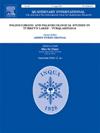Transient fluvial incision in the Western Han River Basin: Implications for the late Cenozoic rock uplift of the Western Qinling Mountains, northeastern Tibetan Plateau
IF 1.9
3区 地球科学
Q3 GEOGRAPHY, PHYSICAL
引用次数: 0
Abstract
Situated in the northeastern Tibetan Plateau, the Western Qinling Mountains have undergone foreland propagation and surface uplift due to the northeastward expansion of the Tibetan Plateau since the late Cenozoic. In this study, the differential rock uplift and fluvial incision were investigated by extracting longitudinal profiles of the 227 major tributaries of the Western Han River Basin, which are located in the hinterland of the Western Qinling Mountains. Of 227, 178 tributaries have “slope-break” knickpoints. Channel segments upstream of knickpoints with low steepness indices represent the relict low-relief landscape, while the downstream of knickpoints with higher steepness indices represents the adjusting landscape formed after the knickpoint initiation. The spatial patterns of channel steepness indices show the western part of the Western Han River Basin having a higher rock uplift rate than the eastern part. Three-stage rock uplift of the Western Qinling Mountains has been identified by the shape of the longitudinal profile of the Western Han River. The magnitude of fluvial incision in the three-stage is about ∼180 m, ∼380 m, and ∼100 m, respectively. The results of this study reveal that the tectonic uplift of northeastern Tibetan Plateau has regulated the late Cenozoic rock uplift and fluvial incision in the Western Qinling Mountains, and highlight the potential use of channel profiles as indicators for tectonic forcing.
西汉江流域瞬时河流切割:对青藏高原东北部西秦岭晚新生代岩石隆升的启示
西秦岭位于青藏高原东北部,晚新生代以来受青藏高原东北扩张的影响,经历了前陆扩张和地表隆升。本文通过对西秦岭腹地227条西汉流域主要支流的纵向剖面提取,研究了该流域的岩石隆升和河流切割差异。在227条支流中,有178条有“坡折”小点。坡度指数较低的断裂点上游河道段为残存的低地形景观,坡度指数较高的断裂点下游河道段为断裂点形成后形成的调整景观。河道陡度指数的空间格局表明,西汉流域西部的岩石隆升速率高于东部。根据西汉江纵剖面的形态,确定了西秦岭的三期岩石隆升。三期河流切口大小分别约为~ 180 m、~ 380 m和~ 100 m。研究结果表明,青藏高原东北部的构造隆升调节了西秦岭晚新生代的岩石隆升和河流切割,并突出了河道剖面作为构造强迫指示的潜力。
本文章由计算机程序翻译,如有差异,请以英文原文为准。
求助全文
约1分钟内获得全文
求助全文
来源期刊

Quaternary International
地学-地球科学综合
CiteScore
5.60
自引率
4.50%
发文量
336
审稿时长
3 months
期刊介绍:
Quaternary International is the official journal of the International Union for Quaternary Research. The objectives are to publish a high quality scientific journal under the auspices of the premier Quaternary association that reflects the interdisciplinary nature of INQUA and records recent advances in Quaternary science that appeal to a wide audience.
This series will encompass all the full spectrum of the physical and natural sciences that are commonly employed in solving Quaternary problems. The policy is to publish peer refereed collected research papers from symposia, workshops and meetings sponsored by INQUA. In addition, other organizations may request publication of their collected works pertaining to the Quaternary.
 求助内容:
求助内容: 应助结果提醒方式:
应助结果提醒方式:


